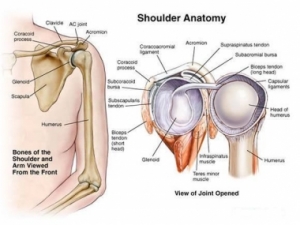Shoulder Pain, tendonitis and Rotator Cuff Injuries
What is Shoulder Pain? Is it tendonitis or a Rotator Cuff Injury?
What most people call the shoulder is really several joints that combine with tendons and muscles to allow a wide range of motion in the arm — from scratching your back to throwing the perfect pitch.
Mobility has its price, however. It may lead to increasing problems with instability or impingement of the soft tissue or bony structures in your shoulder, resulting in pain. You may feel pain only when you move your shoulder, or all of the time. The pain may be temporary or it may continue and require medical diagnosis and treatment.
Anatomy of a shoulder
Your shoulder is made up of three bones: your upper arm bone (humerus), your shoulder blade (scapula), and your collarbone (clavicle).
The head of your upper arm bone fits into a rounded socket in your shoulder blade. This socket is called the glenoid. A combination of muscles and tendons keeps your arm bone centered in your shoulder socket. These tissues are called the rotator cuff. They cover the head of your upper arm bone and attach it to your shoulder blade.
Causes of shoulder pain, tendonitis and rotator cuff injuries
Tendon inflammation (bursitis or tendinitis) or tendon tear
Instability
Arthritis
Fracture (broken bone)
Bursitis in the shoulder
Bursae are small, fluid-filled sacs that are located in joints throughout the body, including the shoulder. They act as cushions between bones and the overlying soft tissues, and help reduce friction between the gliding muscles and the bone.
Sometimes, excessive use of the shoulder leads to inflammation and swelling of the bursa between the rotator cuff and part of the shoulder blade known as the acromion. The result is a condition known as subacromial bursitis. Bursitis often occurs in association with rotator cuff tendonitis. The many tissues in the shoulder can become inflamed and painful. Many daily activities, such as combing your hair or getting dressed, may become difficult.
Tendonitis in the shoulder
A tendon is a cord that connects muscle to bone. Most tendonitis is a result of a wearing down of the tendon that occurs slowly over time, much like the wearing process on the sole of a shoe that eventually splits from overuse.
Generally, tendonitis is one of two types:
Acute. Excessive ball throwing or other overhead activities during work or sport can lead to acute tendinitis.
Chronic. Degenerative diseases like arthritis or repetitive wear and tear due to age, can lead to chronic tendinitis.
The most commonly affected tendons in the shoulder are the four rotator cuff tendons and one of the biceps tendons. The rotator cuff is made up of four small muscles and their tendons that cover the head of your upper arm bone and keep it in the shoulder socket. Your rotator cuff helps provide shoulder motion and stability.
Acute: Excessive ball throwing or other overhead activities during work or sport can lead to acute tendinitis.
Chronic: Degenerative diseases like arthritis or repetitive wear and tear due to age, can lead to chronic tendinitis.
The most commonly affected tendons in the shoulder are the four rotator cuff tendons and one of the biceps tendons. The rotator cuff is made up of four small muscles and their tendons that cover the head of your upper arm bone and keep it in the shoulder socket. Your rotator cuff helps provide shoulder motion and stability.
Tendon Tears in the shoulder
Splitting and tearing of tendons may result from acute injury or degenerative changes in the tendons due to advancing age, long-term overuse and wear and tear, or a sudden injury. These tears may be partial or may completely split the tendon into two pieces. In most cases of complete tears, the tendon is pulled away from its attachment to the bone. Rotator cuff and biceps tendon injuries are among the most common of these injuries.
Shoulder Impingement
Shoulder impingement occurs when the top of the shoulder blade (acromion) puts pressure on the underlying soft tissues when the arm is lifted away from the body. As the arm is lifted, the acromion rubs, or “impinges” on, the rotator cuff tendons and bursa. This can lead to bursitis and tendinitis, causing pain and limiting movement. Over time, severe impingement can even lead to a rotator cuff tear.
Shoulder Instability
Shoulder instability occurs when the head of the upper arm bone is forced out of the shoulder socket. This can happen as a result of a sudden injury or from overuse.
Shoulder dislocations can be partial, with the ball of the upper arm coming just partially out of the socket. This is called a subluxation. A complete dislocation means the ball comes all the way out of the socket.
Once the ligaments, tendons, and muscles around the shoulder become loose or torn, dislocations can occur repeatedly. Recurring dislocations, which may be partial or complete, cause pain and unsteadiness when you raise your arm or move it away from your body. Repeated episodes of subluxations or dislocations lead to an increased risk of developing arthritis in the joint.
Treatment of shoulder injuries, rotator cuff injuries and tendonitis.
We can generally treat the shoulder with hands on therapy and with the possible use of trigger point therapy such as Dry Needling.
When it comes to bursitis and tendonitis we treat very successfully with Shockwave Therapy.

